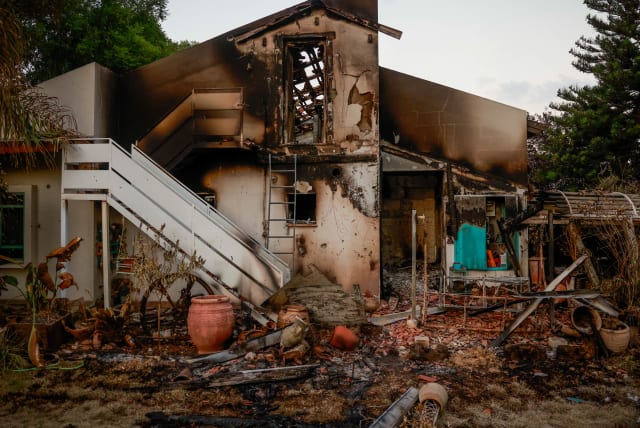Forensic accountants work to quantify damage to Kibbutz Be’eri

Amit Solvy, the economic chairman of Kibbutz Be’eri, predicted that the costs of repair would be as high as 600 million shekels ($159 million).
Roughly a dozen Israeli communities in the Gaza periphery were infiltrated by Hamas as part of the terror group’s October 7 massacre. But few, if any, were as utterly devastated as Kibbutz Be’eri.
According to reports, witness testimony, CCTV footage, and first responders, some 90 armed terrorists arrived at Be’eri before 6 a.m. on what came to be known in Israel as “the black Sabbath.” The Hamas fighters kidnapped 25 community members, including 9-year-old Emily Hand. Five Be’eri members who were taken hostage are still being held in Gaza.
Over 130 people of all ages were murdered on the kibbutz. Some were shot to death, while others were burned alive in their homes. According to first responders, 80% of the recovered bodies showed signs of torture. Some victims were found bound up, decapitated, or with signs of sexual abuse.
An entire kibbutz was destroyed
Aside from the enormous human and emotional toll, the buildings of Be’eri were also ravaged. At least half of the kibbutz’s buildings were burned to the ground, with an estimated cost in the hundreds of millions of dollars just to rebuild.
In the months since the attack, teams of experts, including volunteers from within the community, have been working tirelessly to quantify what was lost.
Retired certified public accountant and auditor Mark Linton, who lives in northern Israel’s Kibbutz Kfar Haruv, was among the first to be tapped for this mission. His close friend, 74-year-old Canadian-born peace activist Vivian Silver, was among those who were murdered at Kibbutz Be’eri. It took authorities 38 days to identify her body.
Members of the kibbutz are no longer living on Be’eri, with most having been displaced to hotels and other communities near the Dead Sea. But they rely on the kibbutz accounting department for their salaries.
“Be’eri is known as a traditional kibbutz,” Linton told The Media Line. “They haven’t been privatized, and everything is still very communal. So the importance of the budget that they get is very paramount for them. I work in a privatized kibbutz, so I pretty much get whatever I make from my salary. But they don’t.”
Instead, Be’eri’s members share the wealth generated both by the kibbutz’s industry as well as by the members’ jobs outside the kibbutz. All the income generated by the kibbutz and its members is pooled and then divided, with family budgets “determined by the size of their families, whatever particular needs they have,” Linton explained.For this reason, kibbutz members were returning to work within days of the October 7massacre.
Amit Solvy, the economic chairman of Kibbutz Be’eri, told The Media Line that hundreds travel to the community every day to rebuild, to work the various industries and businesses on which the kibbutz financially relies, and to otherwise keep the community afloat.
“The kibbutz is full during the day,” he said. “It’s full of people working at the printing press, in agriculture, in carpentry … and the dining room is serving three meals per day.”
By doing this, the kibbutz has also been able to continue paying monthly stipends to its members—relying on previous invoices that were recovered to determine how much each family is owed.
But the kibbutz’s larger financial picture is still lost, and Linton imagines it will take years to fully recover from the mess.
All of Be’eri’s offices were destroyed in the attack, including the accounting office. And of the eight central workers in the accounting department, the chief accountant—55-year-old Ohad Ben Ami—was kidnapped to Gaza, Linton said.
The next four in line were all murdered, “leaving only three people, who were really just starting out in the department, and they don’t know much,” Linton continued. The computers, notes, and papers were destroyed as well.
“I was approached by the head of the company that does the kibbutz’s auditing, and they asked me if I would choose staff and direct them to reinvent the department,” Linton said.
The accounting computers were backed up to the cloud, providing Linton and his team a starting-off point. They had access to information about who the kibbutz owed money to, and who was in debt to the kibbutz. And with that, the team was able to “start doing all the very basic things.”
The complications of rebuilding what was lost
However, the systems in place, the calculations used, and many other records were not recovered, leaving a massive and expensive puzzle to be unraveled. Linton calls the work “forensic accounting.”
“We have to look and see what was done before, and try to guess how they did it,” Linton explained. “And not everything we’re doing is right. Sometimes we get to the same answers in probably a different way. Sometimes we don’t get the right answers at all. It’s very complicated.”
In many cases, the accountants face questions they didn’t know they needed to ask. One example comes from the Be’eri print shop. The print shop does its own business accounting, but every month the kibbutz charges the print shop a certain sum for the labor provided by kibbutz members—effectively collecting wages towards the community’s pooled income.
But Linton doesn’t have any record of how the kibbutz calculates this sum.
“Say you’re a kibbutz member who worked there [at the print shop] 20 days last month…” Linton says he doesn’t know how much the kibbutz should charge the business for this labor. “Are you paid by the hour, by the day, monthly? And there are 100 people like this [for whom they don’t know how to calculate wages].” Yet all these things must be calculated properly and reported to the income tax authorities “because they’re the ones in charge of doling out the [insurance] money to rebuild the kibbutz and to pay for war damages. So we can’t just say, ‘We don’t know, and to hell with it.’”
All told, Linton expects the job to take years to complete, including training a new team of accountants to take over.
Likewise, Solvy says that the community will be moving this summer from resorts near the Dead Sea to a prefab community being built by Kibbutz Hatzerim near Beersheba.
They will live there for at least one and a half years while the 130 or so destroyed buildings on Be’eri are rebuilt and basic infrastructure on the kibbutz is reinstated.
Linton struggled to estimate the damages from the attack. “I could throw out a number and it wouldn’t mean anything,” he said. “Because, first of all, you have to define what you mean by ‘damage.’ Is it just the buildings and the cars and the furniture that was destroyed? How about health problems? How about mental health problems? I don't think anyone has even defined what your question implies.”
That said, Linton concluded that rebuilding a relatively large kibbutz would likely cost over 100 million shekels ($27 million) minimum. “And that’s just the physical,” he said.
Solvy predicted that the costs would be as high as 600 million shekels ($159 million). “And if you want to build a bigger Be’eri—a “Be’eri 2”—then it’s closer to a billion shekels [$265 million],” he said.
The community leaders have been in constant communication with the government to receive state funding earmarked for rebuilding towns in the Gaza envelope. Solvy says roughly 18 billion shekels ($4.8 billion) have been pledged for all the damaged communities in Israel, combined. That budget has yet to receive final approval from the government, however. And the portion Be’eri is set to receive is likewise still unknown.
But no matter how long it takes or how hard they must work, the members are fully intent on returning to their homes. Solvy says the community conducted a poll, and that fewer than 1% indicated that they didn’t want to come back.
Jerusalem Post Store
`; document.getElementById("linkPremium").innerHTML = cont; var divWithLink = document.getElementById("premium-link"); if (divWithLink !== null && divWithLink !== 'undefined') { divWithLink.style.border = "solid 1px #cb0f3e"; divWithLink.style.textAlign = "center"; divWithLink.style.marginBottom = "15px"; divWithLink.style.marginTop = "15px"; divWithLink.style.width = "100%"; divWithLink.style.backgroundColor = "#122952"; divWithLink.style.color = "#ffffff"; divWithLink.style.lineHeight = "1.5"; } } (function (v, i) { });

